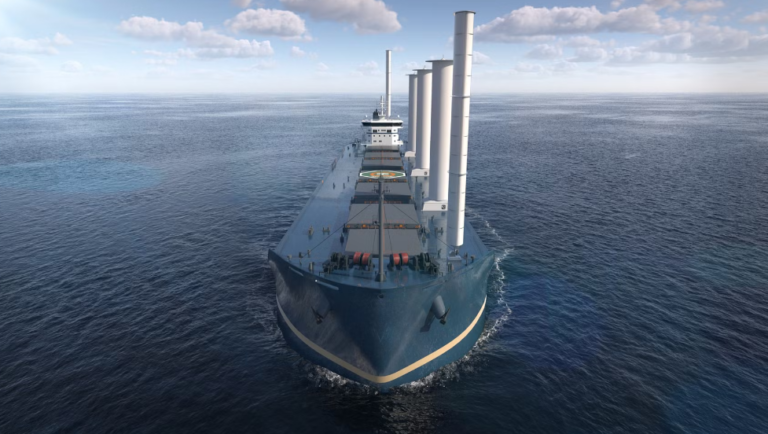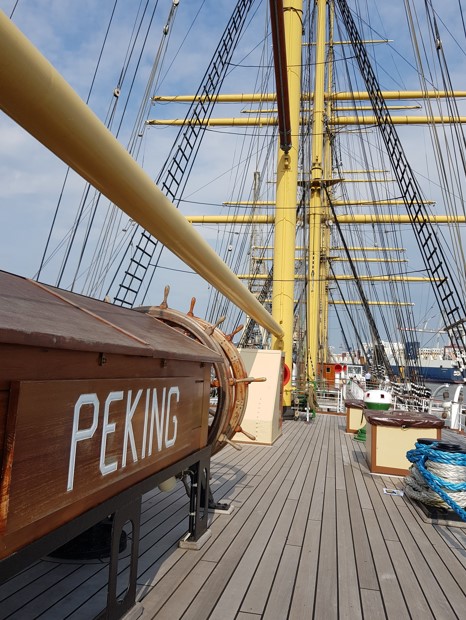2024 was an exciting year in the ongoing development of the wind-assisted ship propulsion segment, with 54 large ships in operation and seven more designated as wind-ready.
2024 was an exciting year in the ongoing development of the wind-assisted ship propulsion segment, with 54 large ships in operation and seven more designated as wind-ready.

Globally, there are also four primary wind vessels, the International Windship Association (IWSA) revealed in January 2025.
What is more, the wind ship orderbook includes80 ships with a further 30-40 in the pipeline for 2026 and 2027, the association added.
Wind ship propulsion is becoming increasingly popular in shipping due to the fact that it is the only ‘free energy source‘. Moreover, the potential of innovative wind propulsion is said to be enormous for green shipping due to the freely available quantities of wind in many shipping areas and the associated savings potential.
“Wind propulsion technologies are neither yesterday‘s nor tomorrow‘s news – now is the time for shipping to use wind energy as a fuel for maritime decarbonisation,”Gavin Allwright, Secretary General of the International Windship Association (IWSA), stressed at the Wind Ship Day 2024 that was organized on board Peking, a traditionally-rigged sailing vessel in Hamburg on September 4, 2024.

According to IWSA forecast, there will be around 10,000 ships worldwide with installed wind (auxiliary) propulsion by 2030 and up to 40,000 ships by 2050.
Allwright added at the event in Hamburg that wind would completely pay for decarbonization by 2050 and effectively cover the cost of alternative fuels.
It is understood that, with wind propulsion systems, wind energy is harnessed directly to generate propulsion thrust without additional intermediaries. There are two ways to use wind propulsion on board ships – as assisted propulsion where the ship relies on wind propulsion to assist the main propulsion system and as main propulsion where the vessel relies primarily on wind power for propulsion.
As per Bureau Veritas, wind can be considered the main propulsion if more than 50% of the ship’s propulsive energy over a full year of operation derives from this energy source.
Based on the division between auxiliary and main propulsion, Offshore Energy made a selection of wind propulsion-related articles that defined 2024.
Wind as auxiliary propulsion
- VLOC Sohar Max becomes ‘world’s largest’ ship with wind propulsion tech
- Jumbo installs ‘first’ wind-assisted propulsion systems on heavy lift vessel
- Wallenius Marine conducts design tests for ‘world’s first’ wind-powered PCTC
- ‘World’s first’: Nuclear transport operator picks wing sail technology to install on its ships
- Japanese consortium unveils eco-friendly methanol-powered VLCC design
- MOL obtains ‘world’s first’ approval for LNG carrier with wind-assisted propulsion
- KCC to install ‘largest ever suction sails’ on CABU III newbuild
- 20 bound4blue eSAILS set for installation across five Maersk Tankers’ vessels
- Deltamarin to design LDA’s new wind-powered ROROs
- 100,400 dwt bulker Oldendorff Chinook debuts Norsepower rotor sails
- BREB gears up to deploy wind-powered methanol-ready MPP fleet in 2025
- Japanese trio joins forces on development of rigid sails
- Union Maritime to equip 34 tanker newbuilds with WindWings
- Kongsberg: New ‘super-efficient’ bulker design unveiled
- Bound4blue installs first fixed suction sails on RoRo ship
Wind as main propulsion
- World’s largest modern cargo sailboat christened in France
- Levelling up maritime decarbonization game: Captain Arctic, a new solar sails/electric cruise ship concept
- TOWT christens first sailing cargo vessel, lays keel for the third ship
- Keel laid for Neoline’s first sailing cargo ship
- TOWT: Second sailing cargo ship arrives home
- KR: Low-carbon sailing ship ready to serve Marshall Islands
- Chantiers de l’Atlantique: Steel cut for ‘world’s largest’ sailing ship
… and many more.
The regulatory side of the coin
When it comes to the regulatory landscape, 2025 promises to be prosperous for the development of the wind ship propulsion segment, too. The year started with the EU bringing into force the FuelEU Maritime regulation with its significant <5% additional reward factor for wind installations enabling compliance up to 2030 through wind alone.
Related Article
Specifically, a ship with installed wind-assisted propulsion technologies, such as kites, rigid sails, suction, or rotor sails, can benefit from a reward factor that effectively improves the annual average GHG intensity of the energy used onboard. This improvement can go up to 5%, depending on the ratio between the effective wind power and the installed propulsion power of the ship.
As per the EU Commission, the installation of wind assisted propulsion (WAP) systems can contribute to compliance with FuelEU through an effective reduction of the calculated annual GHG intensity of the energy used onboard. This, in itself, represents a way of supporting economic feasibility for WAP systems, reducing the need to invest in the use of more expensive renewable and low-carbon fuels.
Related Article
Moving to a global regulatory landscape, the International Maritime Organization (IMO) was urged in 2024 to agree on a strong revision of the Carbon Index Indicator (CII), a global fuel standard that allows for the uptake of wind ship propulsion, and an ambitious levy to ensure the shipping industry reaches decarbonization targets.
At the Marine Environment Protection Committee’s (MEPC) 82, IWSA submitted a paper setting out that wind energy can be incorporated into the mid-term measures developed to implement the 2023 IMO Strategy on Reduction of GHG Emissions from Ships.
The paper proposes an amended formula that could be used to calculate the attained Greenhouse Gas Fuel Intensity (GFI) which provides a concrete illustration of the technical proposal so that wind energy is accounted for equitably in the greenhouse gas emissions intensity balance for the ship.
Related Article
-
It’s time for the IMO to recognize wind propulsion
Regulation & Policy
READ MORE
Content Original Link:
Original Source OFSHORE ENERGY
" target="_blank">



























































